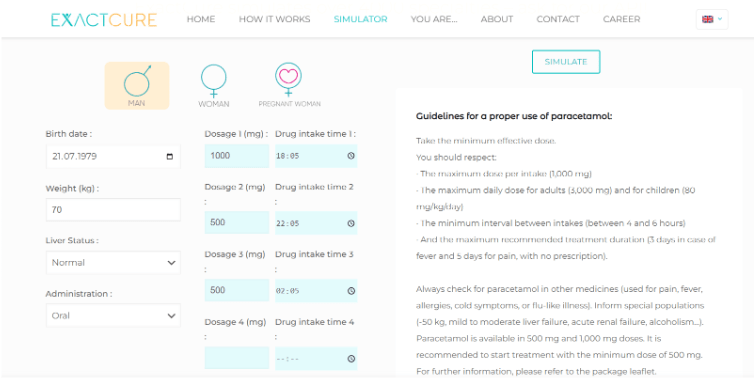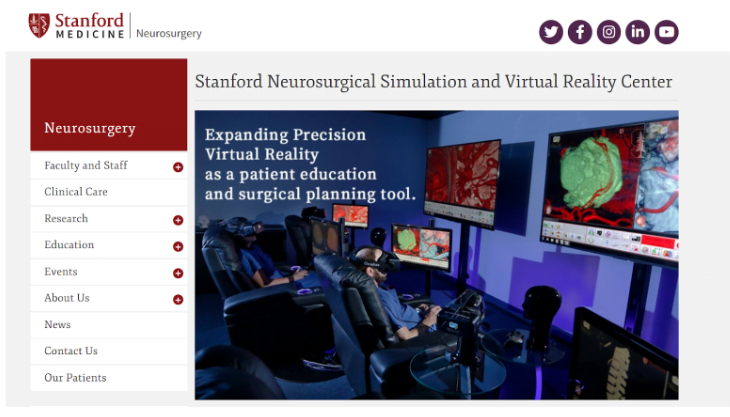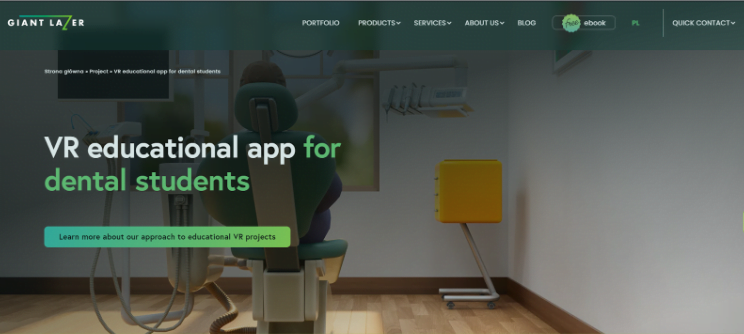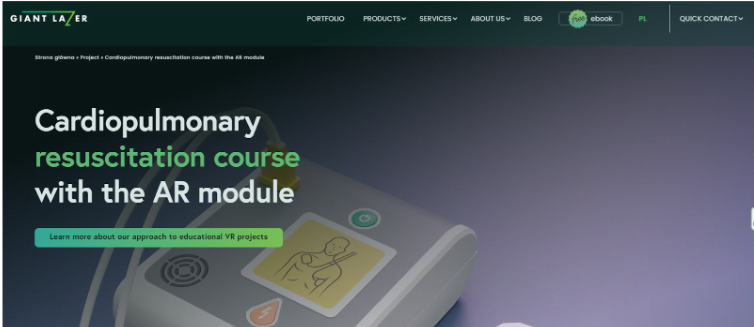The integration of Virtual Reality (VR) into the field of medicine might initially strike some as a futuristic concept, akin to an ambitious dream, especially given the common association of virtual reality with gaming. Nevertheless, as technology continues to progress the growing role of VR in medicine becomes undeniable.
However, as technology advances, the growing role of VR in medicine is undeniable.
In the following article, we’ll take a closer look at the impact of virtual reality on the medical world, examining how the technology is transforming medical procedures, staff training and the quality of healthcare.
So let’s find out what promising prospects VR brings to the future of medicine.
VR and its application in the medical field
The application of VR in medicine is extensive and diverse. This is indicated not only by the projected possibilities, but also by numerous studies conducted by prominent medical institutions around the world. As Puls Biznesu points out:
“According to the latest estimates of the american research company Reports and Data, last year the market of virtual reality solutions in the medical area was worth USD 1.78 billion, and by 2026 is expected to grow to almost USD 7 billion on a global scale.”
This means that the VR market in the medical field will almost quadruple in the coming years!
In the realm of the healthcare sector, virtual reality emerges as a versatile tool, finding applications in therapy, rehabilitation, and the training of medical professionals.
What’s more, VR enables complex surgical simulations that help doctors and students hone their skills without risking the health and lives of patients.
Also, the importance of VR in medical education cannot be overlooked. With the help of virtual reality, medical students can practice surgical procedures in a safe virtual environment, allowing them to gain valuable experience before entering the operating room and facing real cases.
VR in diagnostics and medical imaging
Today’s surgery can do things that not so long ago we would have called a miracle (such as performing surgery on a baby in the womb).
But let’s not forget that every treatment starts with a diagnosis, and VIrtual Reality has emerged as a transformative tool, enhancing the effectiveness of diagnoses. This is made possible through the immersive visualization and simulation capabilities inherent in virtual reality technology..
VR scenarios, created for each simulation, can be used in unlimited ways – from making a virtual 3D anatomical model of a specific patient, helping to make medical imaging more effective, to seeing how the patient’s body will react to proposed treatments.
However, the application of VR in medicine goes much further. In addition to supporting the diagnosis of physical conditions, virtual reality can be used in psychiatry. The immersive nature of VR can be harnessed to construct environments that expose individuals to stimuli capable of triggering psychotic states, facilitating the confirmation or ruling out of specific psychiatric conditions.
As Dawid Kruk points out in the journal Polish Psychiatry:
” On the Polish ground, interventions using VR in the treatment of psychotic disorders are few, but in highly developed countries such as the United Kingdom, the Netherlands and South Korea, there is currently a dynamic development of this field. There are already several reviews in the English-language literature on the use of immersive VR in the diagnosis and treatment of psychotic disorders. However, it should be noted that most of them include, in addition to work using immersive VR, studies using non-immersive virtual reality technology, and, due to the date of publication, do not include several relevant studies conducted on larger samples, discussing the effects of CBT-VR therapy and avatar therapy, among others.”
Application of VR in research – examples
While the aforementioned instances may appear to be a glimpse into the future, there already exist virtual reality applications that assist medical professionals in diagnostics and comprehensive research. Let’s explore a few examples in the realm of research.
Living Heart
In today’s fast-paced world, unhealthy eating habits and lack of regular physical activity are leading to an increase in the number of people suffering from lifestyle diseases such as obesity, diabetes and heart disease.
In Poland alone, about 180,000 people die of cardiovascular disease, accounting for almost 50% of all deaths. Worldwide, meanwhile, the number of deaths from cardiovascular failure has increased by 60% in the last 30 years.
It was this alarming data that prompted the creation of the Living Heart project.
Originating in the United States, this initiative aids cardiologists throughout the entirety of a patient’s treatment journey. It starts with the creation of an autonomous, personalized model of the heart and extends to facilitating precise diagnoses, ultimately guiding the selection of the most effective treatment options.
Simulations created by Living Heart can also indicate if and how much risk a patient has of developing a particular cardiovascular disease in the future.

Source: 3dexperiencelab.3ds.com
ExactCure
The breakthrough brought about by using VR in medicine also involves personalizing treatment on an unprecedented scale.
One of the projects taking part in this medical revolution is ExactCure. Its main goal is to minimize the risks associated with medication errors and their use.
The application uses and processes all of the patient’s parameters, such as age, height, weight, genetic conditions, and uses these to select the most effective, but also safest, type of drug therapy, e.g. which dose of paracetamol will be the least harmful.

Medical VR apps from Giant Lazer
VR applications in medicine have also been in the news in our home market, and Giant Lazer’s solutions have been a big part of this.
Speaking of the medical industry, at Giant Lazer we are currently focusing on the educational aspects, offering a wide range of VR training courses for medical students and staff.
We will have more to say about our products later in this article. In the meantime, let’s get back to other applications of VR in medicine.
Try VR medical apps from Giant Lazer!
Sing up for a free 30-minute consultation and see what we can do for you!
VR therapy
We have already mentioned the increasing role of VR diagnostics, imaging and simulation to improve treatment.
But this is not the end of the story.
Virtual reality has also found its way into the world of therapy.
Virtual reality therapies are opening up new perspectives in the treatment of various diseases and conditions and are helping to improve the quality of life of many patients, including those suffering from mental illness as well as struggling with the aftermath of nervous system dysfunctions.
The use of VR in psychotherapy and rehabilitation
Virtual reality is becoming increasingly popular in the field of psychotherapy. Thanks to the immersion method, patients are able to enter a virtual world that allows them to explore and work through difficult situations, helping them to cope with their fears, phobias or traumas.
The use of virtual reality-based therapy allows patients to confront distressing stimuli in a safe way, so that they are able to gradually minimize the negative emotional reactions associated with these triggers.
For this reason, professionals are increasingly using VR in cognitive behavioral or exposure therapy, as well as in the treatment of people on the autism spectrum.
VR-enhanced therapy can be based on specific, highly visualized scenarios. These can include encounters with panic-inducing objects (spiders, snakes), difficult social situations (public speaking) or even flight.
As far as rehabilitation is concerned, the application of VR is just as broad, although at the moment it is mainly used to work with stroke patients.
Stroke often results in problems with cognitive functions and the nervous system. Many patients complain of memory and attention problems, as well as physical limitations such as facial paralysis.
VR’s potential in this area is huge, and some researchers even claim that using virtual reality to treat post-stroke patients produces better results than traditional methods, as in the case of researchers from Portugal.
Experts are also suggesting that VR could be used to rehabilitate patients with neurological conditions, including Parkinson’s, MS, ALS, ADHD, Down syndrome and FAS.
Treating pain and stress with VR therapy
Using Virtual Reality to help manage pain and reduce stress is a fascinating field that’s also on the rise.
It’s not surprising when you consider that one of the most effective approaches to pain management is often a simple distraction, and virtual immersion is proving to be extremely beneficial in this regard.
To illustrate this, consider how a special app was developed to help children get vaccinated. Instead of subjecting them to the discomfort of a clinical and sterile vaccination room, children were transported to a virtual adventure where they acquired a shield of superpowers. See this innovative concept in action:
Nevertheless, Virtual Reality is proving to be a valuable tool for pain relief across a range of age groups. In addition to its use in pediatrics, VR can be effectively used to reduce pain associated with childbirth, dental procedures, colonoscopies and vasectomies.
The application of VR technology in the management of chronic pain is also noteworthy. Ongoing research is exploring the potential benefits of VR for people with chronic pain in areas such as lumbar and neck, as well as those with knee problems or fibromyalgia.
Another particularly important application of virtual reality in medicine is its invaluable contribution to the study of the intricacies of stress. This is done by visualizing and introducing stressors under controlled conditions.
Additionally, virtual reality plays a pivotal role in combating stress, utilizing applications for activities such as meditation.
Practical examples of VR therapy in medicine
While many of the applications of VR in medicine and therapy are still being explored, it is already clear that it has the potential to be a game-changer in the treatment of patients with pain and stress.
For example, in their study of patients with extensive body burns, Washington University researchers chose to use distracting VR applications during ROM training, resulting in patients experiencing significantly less discomfort and pain than those receiving traditional therapy.
Replacing and improving mirror therapy for limb amputees experiencing phantom pain is another example of VR therapy in medicine.
VR medical training
When it comes to the use of VR in medicine, there is one topic that has yet to be mentioned – VR medical training.
Virtual reality medical training is an innovative step into the future of medical education, allowing students and medical professionals to gain experience in a well-designed simulation.
So what can we expect?
Surgical simulators and training for medical staff
When it comes to surgical training, surgical simulators are essential. They allow doctors and nurses to simulate various surgical procedures on near-realistic 3D models. This increases their confidence and skills in real clinical situations.
These advanced technologies give medical staff access to modern training tools that improve healthcare standards.
After all, trained staff means safer and more effective care.
Benefits of virtual reality training
There are many benefits to Virtual Reality training, both for the participants and the organizations providing the training. Here are some of the key benefits of virtual reality training:
- Realistic experience – VR can be used to simulate realistic scenarios. This allows participants to practice in a realistic context.
- Safe training environment – with VR training, trainees can try, make decisions and develop skills in a controlled, safe setting.
- Accessibility and scalability – with Virtual Reality technology, the training is easily accessible to participants from different locations around the world, enabling them to share experience and knowledge on a global scale.
- Interpersonal and empathic skills development – VR training can involve interacting with virtual characters to help develop interpersonal skills and raise awareness, especially in areas such as communicating with the patient or working with the team.
- Progress tracking – VR platforms can be used to track participants’ progress. This allows medical training to be fully individualised and tailored to the participant’s current needs.
- Stress reduction – virtual reality, which allows free experimentation and exploring a case without the patient present, effectively reduces stress levels in medical students and staff.
Inspiring VR training examples
Virtual Reality (VR) training programs have become increasingly popular in esteemed educational institutions and are also offered commercially by numerous companies. Let’s explore three noteworthy examples.
Stanford Neurosurgical Simulation and Virtual Reality Center
Established in 2016, the center is the first in the North Pacific to use patient-specific VR technology both in operating theaters and during the lectures.
VR applications and programmes are also being used by Stanford University as a training tool, allowing students to explore diagnostic entities such as aneurysms, genetic defects, tissue or spinal deformities.

Source: https://med.stanford.edu/neurosurgery/divisions/vr-lab.html
VR educational app for dental students
While a significant amount of virtual reality research is conducted abroad, Poland also proudly hosts numerous medical VR applications and training programs.
For instance, at the Medical University of Warsaw, students have access to a unique application designed to train them in dental procedures. The training comprises five practical modules covering tasks such as cavity preparation, endodontic treatment, and incision of a jaw abscess.
Prior to beginning each module, students undergo a tutorial mode, and the application serves as an excellent tool for preparation before exam sessions.

Source: https://giantlazer.com/project/vr-educational-app-for-dental-students/
Cardiopulmonary resuscitation course with the AR module
Cardiopulmonary resuscitation (CPR) plays a crucial role in initial assistance during unexpected cardiac arrests, and executing it accurately can be vital for saving a person’s life. Therefore, it is essential to understand and be proficient in applying this procedure during emergencies.
It is for this reason that the Medical University of Warsaw has once again opted for modern solutions and, together with Giant Lazer, has decided to create an innovative CPR course for future medical professionals.
A key focus of this course is the capacity to regulate the force and frequency of chest compressions in the context of first aid. This ensures that students and healthcare practitioners acquire the necessary skills to perform CPR correctly, minimizing potential repercussions such as rib fractures in the patient.

Source: https://giantlazer.com/project/cardiopulmonary-resuscitation-ar/
Looking for a medical VR app? Try out Giant Lazer!
As you can see, the applications of VR in medicine are virtually limitless, which is why this field is set to grow in popularity in the coming years.
On the Polish market, Giant Lazer is a pioneer in providing advanced VR solutions for the medical industry.
Our applications are designed to meet the specific needs of our customers. If you want to improve the skills and knowledge of your employees, consider using our technology!
With Giant Lazer, the unreal becomes possible!
Book a free consultation to see what we can do for you.

